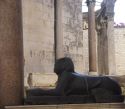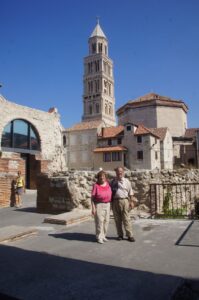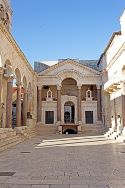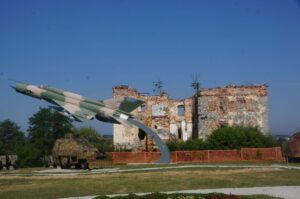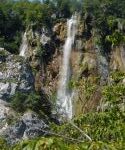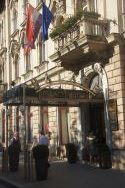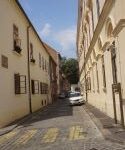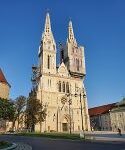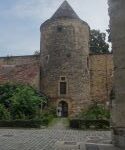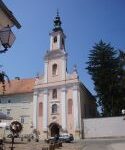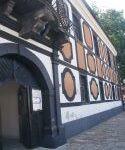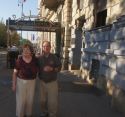July 29, 2013
We didn’t go too Hvar, but we did go to Hvar
One of the islands we stopped at today was Hvar, (it’s not hvar from Split; the ferries in the harbor at Split left every half hour) and it says a lot about a Mediterranean climate that hotels at the island charge only half price if you’re there when it rains. The island enjoys about twice as much sunshine as Paris, though I’ll bet there’s more to do when it rains in France than when it rains in Hvar, though most people, apparently, don’t find out. It’s no wonder the population is almost triple in the summer, with pebbled and sand beaches, a 1600 foot climb to the mountain backbone (that’s on bike route 1), and the usual panoply of agriculture in the Mediterranean—olive trees, fig trees, with some special herbs, including a variety of lavender that was the backbone of the economy until the locals discovered tourism
was easier and paid better. But I did find out that a) lavender ice cream is tasty, and b) there are at least five varieties of lavender.

The settlement of the island goes back a long ways (like everyplace around here), with Greeks from one of the islands invading (too much population at home) in the 4th century BC and settling; as usual, the Romans followed, but the formative years were under the Venetians, who shaped Hvar, and  helped beat back the Turks, who twice burned Hvar to the ground. The port city has a stunning fort on top of the hill, and a wall that has an unusual history—it encircled the nobles’ portion of the town, because the nobles and the tradesmen fought—in fact there was a four year war in the early 16th century that culminated in a truce, celebrated by building a theater!
helped beat back the Turks, who twice burned Hvar to the ground. The port city has a stunning fort on top of the hill, and a wall that has an unusual history—it encircled the nobles’ portion of the town, because the nobles and the tradesmen fought—in fact there was a four year war in the early 16th century that culminated in a truce, celebrated by building a theater!
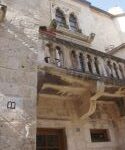
 The town had the usual sights—summer items including snorkeling gear, restaurants and bars, coffee shops, and the standard Benedictine/Franciscan/Cathedrals. The unusual Benedictine nunnery, though, has the motto, “work and prayer,” and, according to our guide, the nuns exit only for funerals or other emergencies. The main fundraiser is an exquisite lace, made from agape leaves (the century plant), that is made for displays. The cheapest one is $67, so a postcard for 50 cents had to satisfy my curiosity.
The town had the usual sights—summer items including snorkeling gear, restaurants and bars, coffee shops, and the standard Benedictine/Franciscan/Cathedrals. The unusual Benedictine nunnery, though, has the motto, “work and prayer,” and, according to our guide, the nuns exit only for funerals or other emergencies. The main fundraiser is an exquisite lace, made from agape leaves (the century plant), that is made for displays. The cheapest one is $67, so a postcard for 50 cents had to satisfy my curiosity.
Every family on the island, supposedly, makes its own wine, and to prove how good it is, we stopped at a vineyard where the owner described the different wines (4) that she and her husband make—the fifth generation to do so. The operation was near a fortified church, fortified after a Turkish invasion in 1571 (the last time the Turkish navy invaded Europe), whose walls looked for all the world like the prow of a ship.
It was that Turkish invasion that contributed, in part, to the charm of the next port of call, Korcula; the view from the Adriatic as we approached the fortified city was stunning. Though the walls are half as high as they 
 originally were (over 60 feet), many of the original houses within remain. It was a walled city, one of the oldest settlements in Europe. The main entrance to the town is through a gate that has a street straight through the city; the side streets are curved
originally were (over 60 feet), many of the original houses within remain. It was a walled city, one of the oldest settlements in Europe. The main entrance to the town is through a gate that has a street straight through the city; the side streets are curved 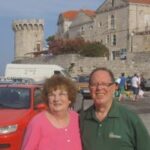 and narrow. They tell us that from above Korcula looks like a fish bone. The reason is that the straight street catches the breeze in the summer (our guide referred to the “air conditioning,” and it’s really breezy today), while the side streets being curved block the bad winds in winter. If you burn down cities often enough, you eventually learn how to build them right.
and narrow. They tell us that from above Korcula looks like a fish bone. The reason is that the straight street catches the breeze in the summer (our guide referred to the “air conditioning,” and it’s really breezy today), while the side streets being curved block the bad winds in winter. If you burn down cities often enough, you eventually learn how to build them right.
 We were in Korcula on a special day—July 29 is the feast of St. Theodore, and Croatia, being 95% Catholic, celebrates Saint’s days. There was a special procession from the Cathedral of St. Marks, the main church in the old city, with a golden sarcophagus containing the remains of St. Theodore (supposedly). Twice a year (the other day being Good Friday), clothing (a 16 pound vestment), the ancient mace, etc. are trotted out to be in the parade. The town also has a folk dance, which used to be only on July 29, the Moresca, a battle between good and evil warriors that we were told has its roots in the enmity between the Turks and the Croatians. (I don’t think they get many Turkish visitors, but nowadays the dance is described as a war between the Black King and the Red King.)
We were in Korcula on a special day—July 29 is the feast of St. Theodore, and Croatia, being 95% Catholic, celebrates Saint’s days. There was a special procession from the Cathedral of St. Marks, the main church in the old city, with a golden sarcophagus containing the remains of St. Theodore (supposedly). Twice a year (the other day being Good Friday), clothing (a 16 pound vestment), the ancient mace, etc. are trotted out to be in the parade. The town also has a folk dance, which used to be only on July 29, the Moresca, a battle between good and evil warriors that we were told has its roots in the enmity between the Turks and the Croatians. (I don’t think they get many Turkish visitors, but nowadays the dance is described as a war between the Black King and the Red King.)
Like many of the Dalmatian coast areas, this was settled first by Dalmatic tribe, then Greeks (a wave from Corfu, who gave it the name Korcula, meaning black for the forests they saw), then another wave of Greeks (300 BC) who had a more lasting impact, writing a covenant that divided the land 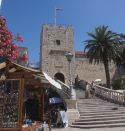 between the two tribes (constituting one of the first written documents in the now Slav world, we were told), then, for 500 years, was under the Venetians. The Venetians gave language (the local dialects are
between the two tribes (constituting one of the first written documents in the now Slav world, we were told), then, for 500 years, was under the Venetians. The Venetians gave language (the local dialects are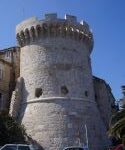 closer to Italian than to Hungarian, unlike northern Croatia) and architecture, among other things. There were the loggias and other archways characteristic of Venice. Napoleon’s conquest and establishment of the Kingdom of Italy temporarily put Korcula in that country—until it was captured by the British and was ruled by the Brits for a few years; the Congress of Vienna in 1815 made it part of Austria-Hungary until 1919, when it became part of Yugoslavia. Now, having established their own country for the first time since the 12th century, some Croatians are opposed to being in the European Union because “it takes away our independence.”
closer to Italian than to Hungarian, unlike northern Croatia) and architecture, among other things. There were the loggias and other archways characteristic of Venice. Napoleon’s conquest and establishment of the Kingdom of Italy temporarily put Korcula in that country—until it was captured by the British and was ruled by the Brits for a few years; the Congress of Vienna in 1815 made it part of Austria-Hungary until 1919, when it became part of Yugoslavia. Now, having established their own country for the first time since the 12th century, some Croatians are opposed to being in the European Union because “it takes away our independence.”

Korcula’s main claim to famous personages is Marco Polo, who was probably born here. Interestingly, after coming back from China, he raised enough money to equip a warship against the Genoans, was captured in a battle off Korcula, and spent a year in prison. He knew lots of languages, but couldn’t write; his memoirs were dictated when he was in the Genoese prison. While he died in Venice and is buried there, Korcula boasts two Marco Polo related museums (one a chronicle of his life with dioramas; the other the tower of his supposed birthplace), and no fewer than 6 Marco Polo officially-approved souvenir shops. Not bad for a town of approximately 3000 people today, some of whom are named de Polo.
The other highlight? We had enough free time to swim in the Adriatic, which was quite salty. Clear, not as warm as it looked, with crabs visible, it was still a nice treat on a hot day.


